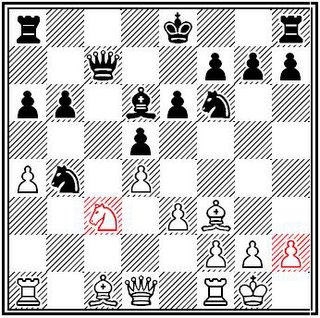Subtle Advantages
 One of the key problems with tactics programs and tactics books is that they focus on extraordinary situations/positions. For example, the unseen bishop fork you are supposed to find attacks two rooks, or the "correct" queen sacrifice you are looking for leads to checkmate. Very rarely do such books or problems deal with much more simple and subtle maneuvers. As a point, I can't recall any such problem where the solution to a given tactics exercise was the gain of a pawn. However, such subtle moves are how games are won!
One of the key problems with tactics programs and tactics books is that they focus on extraordinary situations/positions. For example, the unseen bishop fork you are supposed to find attacks two rooks, or the "correct" queen sacrifice you are looking for leads to checkmate. Very rarely do such books or problems deal with much more simple and subtle maneuvers. As a point, I can't recall any such problem where the solution to a given tactics exercise was the gain of a pawn. However, such subtle moves are how games are won!Diagram 1 (left) is an example of a position I came across the other day in one of my FICs games. It is black to move.
The key move is 1... Qc7. Notice how the Black queen is forking the unprotected c3 knight and also the h2 pawn (more specifically the queen is reinforcing black's own d6 bishop's attack on the h2 pawn). See Diagram 2 (below) with the threatened pieces in red.
 One of those pieces must now fall. The logical choice is, of course, saving the knight, with 2. Bb2 probably being the best move. But after 2... Bxb2, black has a not only a solid pawn advantage, but white's king-side is seriously weakened.
One of those pieces must now fall. The logical choice is, of course, saving the knight, with 2. Bb2 probably being the best move. But after 2... Bxb2, black has a not only a solid pawn advantage, but white's king-side is seriously weakened.
 In the current game, I was actually able to fully exploit this advantage to victory. The position in Diagram 3 (left) was reached about 5 or 6 moves later. It is mate in two (black to move). 1... Qh6+. 2. Kg1 Qh2#.
In the current game, I was actually able to fully exploit this advantage to victory. The position in Diagram 3 (left) was reached about 5 or 6 moves later. It is mate in two (black to move). 1... Qh6+. 2. Kg1 Qh2#.
Now I was able to see the original fork (Diagram 1), but I remember being rather surprised that I did so. I truly believe such subtle moves are intrinsically harder to see because all my tactics exercises focus on more substantial tactics (i.e., where the award is greater than just capturing a pawn).


2 Comments:
what do you use for tactics? my vote is CT-ART which has a ton of problems and is mostly composed of the "subtle" tactics that you mention above
Perhaps it is worth mentioning that in the first diagrammed position Black can also gain a pawn with 1...Bxh2+ 2.Kxh2 Qc7+
Often there is more than one way to carry out a combination!
Post a Comment
<< BACK TO THE REST OF THE SITE!